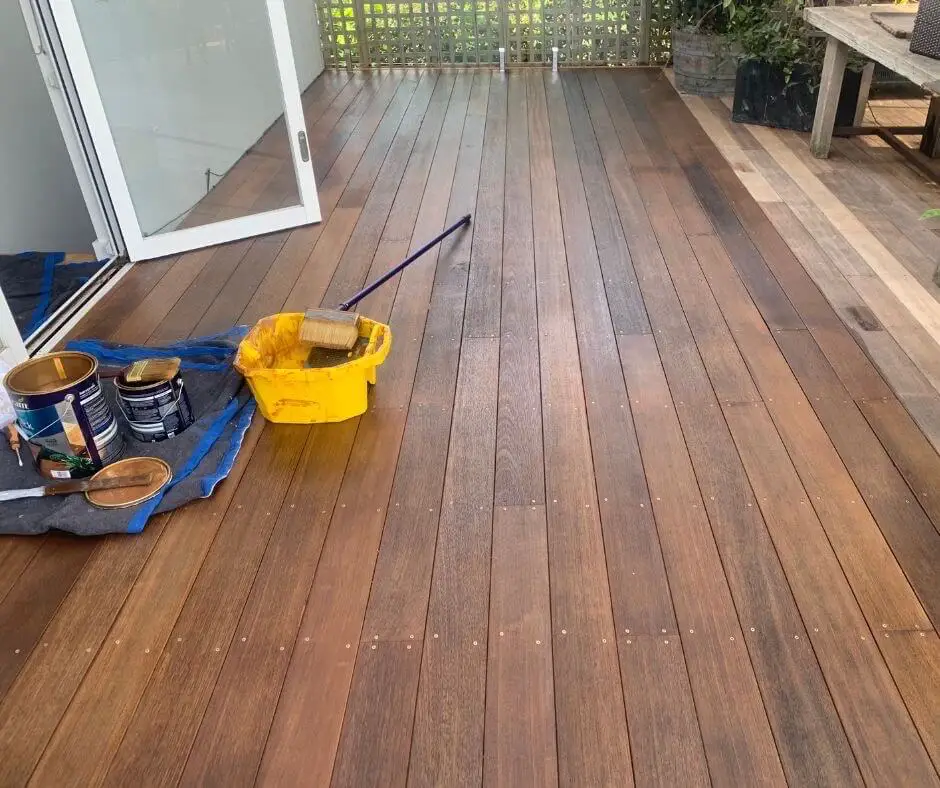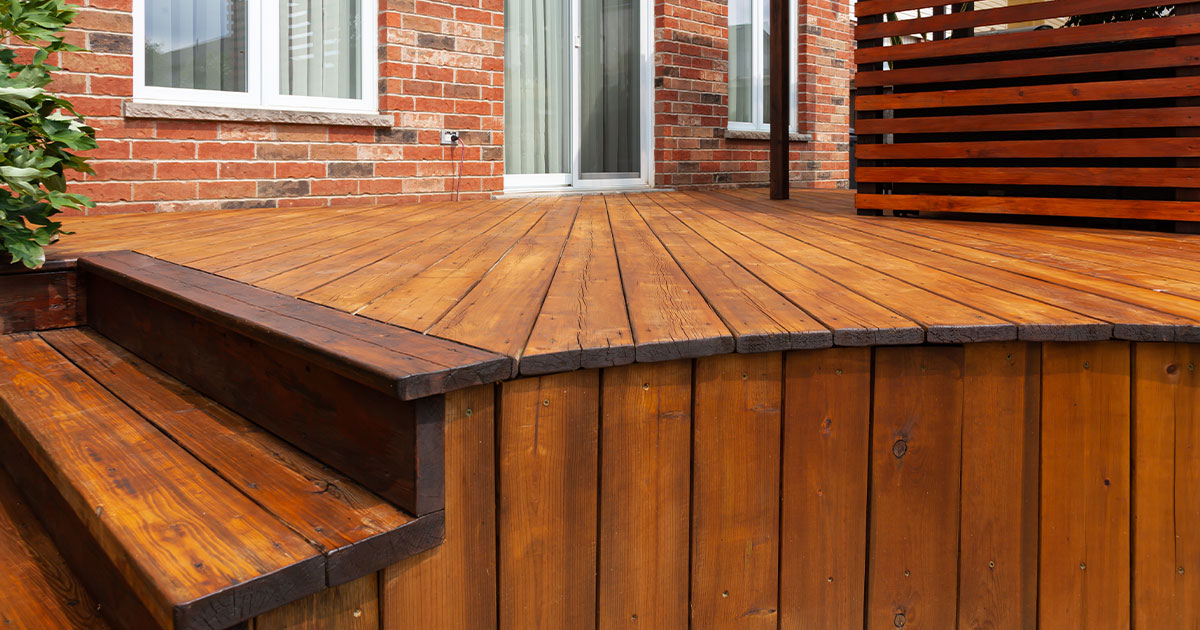Chicago Deck Staining Solutions: Expert Outcomes Ensured
Chicago Deck Staining Solutions: Expert Outcomes Ensured
Blog Article
A Comprehensive Guide to Different Types of Deck Staining Techniques for Ultimate Protection and Appearances
In the world of deck upkeep, the art of tarnishing stands as a critical action towards both preserving the integrity of your outside space and boosting its aesthetic allure. As we navigate via the intricate globe of deck staining methods, one starts to value the nuanced strategies that can make all the distinction in between an average surface and a flawless one. From the choice of the suitable discolor type to the meticulous application approaches, each aspect plays an essential role in achieving that ideal balance in between defense and aesthetics. Join us as we discover the tricks behind achieving the ultimate deck discoloration results-- a trip where every brushstroke forms not just the surface area, however the really essence of your outdoor refuge.
Understanding Various Types of Discolorations
Different sorts of stains are generally used in the procedure of deck staining to achieve different visual and protective impacts. Clear spots are perfect for showcasing the all-natural grain of the timber while offering marginal defense versus UV rays and moisture. On the various other hand, semi-transparent discolorations supply a balance in between color enhancement and security, allowing some wood grain to reveal via. For an extra nontransparent surface that offers optimum protection against the elements, solid discolorations are the preferred selection. These stains can be found in a vast array of colors and successfully hide the wood grain.
In addition, there are also specialized spots such as toners and sealers. Toners add a hint of color to the wood while offering very little defense, making them ideal for more recent decks with less wear. Sealers, on the other hand, deal defense against dampness and UV rays without including color, making them a preferred selection for decks that already flaunt a desirable color. Comprehending the features and advantages of each kind of tarnish is crucial for achieving the desired appearance and durability for your deck.
Selecting the Right Spot Color
When considering the visual appeals of your deck staining task, the option of stain shade plays an essential duty in enhancing the safety top qualities of the chosen tarnish kind (Chicago Deck Staining). The color you pick can dramatically affect the overall appearance of your deck, as well as its capability to endure the components gradually
When selecting a tarnish color, it's necessary to consider the existing color design of your home's outside. Harmonizing the deck tarnish with the overall aesthetic of your residential or commercial property can develop a visually attractive and cohesive outdoor area. Additionally, the shade of your deck tarnish can influence the temperature of the deck surface; darker shades have a tendency to soak up even more warm, while lighter colors reflect sunlight and remain cooler.
Additionally, the sort of wood you are tarnishing will additionally affect exactly how the tarnish color appears. Various timber species can engage with the tarnish in various methods, possibly changing the last color. It's a good idea to check the stain on a small, low-profile area of the deck to guarantee the shade transforms out as desired before continuing with the entire project.
Preparing Your Deck for Discoloration
To ensure a successful and lasting deck staining project, comprehensive preparation of the deck surface area is essential. Begin by cleaning the deck extensively to get rid of dust, gunk, mold, and any old tarnish or end up.
Check the deck for any type of damaged or rotten boards that need to be replaced. Hammer down any type of extending nails and sand any type of rough locations to make sure a smooth surface area for staining. Examine for any kind of loose railings or actions that may need tightening up or repair.
When the deck is tidy, dry, and in excellent fixing, consider using a wood brightener to recover the deck's natural color and open the timber pores for much better stain infiltration. Finally, secure any kind of close-by plants, furnishings, or surfaces with plastic bed linen before waging the staining procedure. Appropriate prep work is essential to attaining a professional-looking finish and making the most of the long life of your deck stain.
Using Stain With Different Methods
For a specialist and perfect coating, the approach of using tarnish plays a vital role in improving the appearance and sturdiness of your deck. There are numerous techniques you can utilize to make sure a reliable application of tarnish.
Brushing is a standard approach that allows for precision and control over the quantity of discolor used. It is ideal for intricate areas and getting to between deck boards (Stain Deck). Rolling is a quicker option, covering larger area efficiently. Back-brushing after rolling is suggested to even out the stain and work it into the timber for far better infiltration.
Splashing is an additional popular technique, providing rate and convenience of application, especially for large deck areas. Whichever strategy you pick, making certain correct prep work and complying with supplier guidelines will certainly aid accomplish a resilient and beautiful stain coating on your deck.

Maintaining and Re-staining Your Deck
Correct upkeep and prompt re-staining are vital for investigate this site maintaining the charm and long life of your deck. Regular maintenance tasks include sweeping particles, cleaning with a deck cleaner, and examining for any type of indications of wear or damages. Attending to problems promptly can protect against a lot more significant troubles in the future. When it pertains to re-staining your deck, the regularity depends upon different aspects such as the sort of stain utilized, the climate in your location, and just how much wear and tear your deck experiences. Typically, it is recommended to re-stain your deck every 2-4 years to maintain its defense and looks.
Before re-staining, ensure the deck is tidy, completely dry, and devoid of any kind of previous discolor residue. Sanding may be necessary to smooth out rough locations or eliminate old discolor that is flaking. Select a top notch discolor that fits your deck's material and supplies the wanted level of security. Apply the stain evenly making use of the appropriate strategy talked about earlier in this guide to ensure a lovely and long-lasting surface - Water-Based Stains. By staying positive with upkeep and re-staining, you can delight in a well-protected useful content and aesthetically attractive deck for years ahead.
Final Thought
Finally, understanding the various sorts of deck stains, choosing the ideal shade, correctly preparing the deck, applying stain with various techniques, and re-staining the deck and preserving are important actions for supreme defense and looks. By following these actions, you can guarantee that your deck stays in leading condition for several years to come.
Additionally, the shade of your deck discolor can affect the temperature of the deck surface area; darker shades have a tendency to soak up even more warm, while lighter colors reflect sunlight and stay cooler.
It's advisable to examine the discolor on a little, unnoticeable location of the deck to make sure the color turns out as preferred prior to proceeding with the whole project.

Report this page